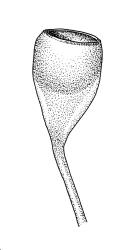- ≡ Physcomitrium jamesonii Taylor, London J. Bot. 6: 329 (1847) – as Jamesoni
Plants yellow-green. Stems red-brown, to 4 mm, branching once by subperigonial innovation or with multiple perigonia, hyalodermis faint (usually only a thin outer wall of otherwise thick-walled epidermal cells), beset with red-brown rhizoids. Leaves erect, ovate-lanceolate, 0.7–1.7(–2.2) × 0.2–0.4(–0.6) mm (including comal leaves), concave to subtubulose, gradually or abruptly tapered to a subulate apex, entire; upper laminal cells oblong, 25–70 × 12–15 µm, becoming longer (to c. 105 µm), laxer and more hexagonal below; marginal cells not differentiated; apical cell 30–48 µm; alar cells not differentiated. Costa 25–37 µm wide near base, failing in the subula. Axillary hairs not seen.
Autoicous. Perigonia single or multiple, but perigonia and perichaetia otherwise as per genus. Setae 2.5–9 mm, sinistrorse throughout, red-brown, weakly hygroscopic; capsules erect, symmetric, oblong-pyriform, not or very weakly constricted below mouth when dry, 1.0–1.3 × 0.5–0.7 mm, with a gradually tapered, irregularly wrinkled neck c. ½ the capsule length, red-brown at maturity; mouth c. ¾ the capsule diameter (at dehiscence), transverse, gymnostomous; exothecial cells c. 30–60 µm, 3–6:1, in cross-section with thick, cuneate anticlinal walls, 6–8 rows oblate and more pigmented at mouth; operculum plano-convex, c. 325–350 µm diameter. Peristome absent. Spores 30–36 µm, verrucate-bullate and usually irregularly wrinkled, usually with obvious trilete scar.
The narrowly ovate-lanceolate leaves make this taxon nearly unmistakable in a regional context. Confusion could conceivably occur with erect-capsuled members of the Bryaceae. However, the distinctive cucullate-rostrate calyptra, the perigonial paraphyses (with globose or pyriform terminal cells), and the single-celled stomata preclude confusion there.
NI: N Auckland (Te Paki, Mōkaikai Scenic Reserve, Ahipara Plateau, Takapuna, Henderson, Glen Eden), Hawke’s Bay (Wairoa). This subspecies remains poorly documented in N.Z., with several of its documented localities in (now) urban sites.
Australasian. Tasmania*, mainland Australia* (Vic., S.A., W.A.).
On damp, often shaded soil in Leptospermum scoparium scrub or in grassland (including mown grassland). Material from Takapuna is from shaded grass in a golf course. A well-documented collection from Te Paki occurred on "ferricrete" soil. Ranging from near sea level to c. 250 m (Te Paki).
| Category | Number |
|---|---|
| Indigenous (Non-endemic) | 1 |
| Total | 1 |
Australasian material of E. jamesonii s.l. is comparable with Andean (and Central American) material in the critical characters of erect ovate-lanceolate leaves, oblong-pyriform capsules with well-defined necks, poorly developed peristomes, and spores with trilete scars (or persisting in tetrads). Australasian material generally differs by its smaller stature relative to Andean material (including the species type). The stems in Australasian material are ≤4 mm while those of Andean material are ≤8 mm (or ≤20 mm in non-Andean material), the perichaetial leaves are smaller, to 2.2 mm vs to 3.0 mm. The setae (2.5-9 mm vs 12-20 mm), and the capsules (1.0-1.3 mm vs 1.5-2.5) are nearly always shorter. Andean material frequently has dichotomously branched stems, a feature not noted in Australasian material and a rare feature in the genus. One Andean specimen from Peru (P. & E. Hegewald 9174, CHR 609123) is comparable to Australasian material in stature, but has more branched shoots. The nearly constant (but rarely overlapping) difference in plant stature alone is insufficient to maintain the Australasian and Andean / Central American taxa distinct at the species level, and the reduction of the Australasian material to subspecies rank is therefore proposed. Only a single Malesian collection of E. jamesonii has been available at the time of writing, but I have earlier (Fife 1987) considered it synonymous with the Andean taxon, using a broader range of Malesian collections.
Entosthodon jamesonii subsp. jamesonii ranges widely in the northern Andes, Central America, and the Caribbean island of Dominica (Fife 1987). In the northern Andes it occurs primarily in páramos habitats at elevations of >3000 m, but in Central America and Dominica it occurs at lower elevations.
Heterotypic synonyms from Victoria, cited by Fife & Seppelt (2001), include Funaria perpusilla Broth. (Holotype: Heyington, W.W. Watts 196, H-Brotherus!) and Entosthodon minuticaulis Müll.Hal. ex Geh. (Holotype: Moyston, D. Sullivan, H-Brotherus!).




